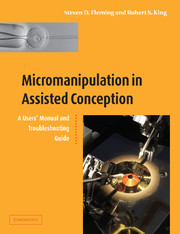Book contents
- Frontmatter
- Contents
- Foreword
- Preface
- Acknowledgements
- Glossary
- List of abbreviations
- 1 Micromanipulation in human assisted conception: an overview
- 2 Media and other consumables for micromanipulation
- 3 Narishige micromanipulation workstation systems
- 4 Eppendorf micromanipulation workstation systems
- 5 Research Instruments micromanipulation workstation systems
- 6 Instrument selection
- 7 Preparation of gametes for micromanipulation
- 8 Intracytoplasmic sperm injection
- 9 Zona manipulation and embryo biopsy
- 10 Microtool manufacture
- 11 Transgenesis and the generation of knock-out mice
- 12 New and advanced techniques
- Appendix: Suppliers and manufacturers of equipment and consumables
- References
- Index
7 - Preparation of gametes for micromanipulation
Published online by Cambridge University Press: 10 September 2009
- Frontmatter
- Contents
- Foreword
- Preface
- Acknowledgements
- Glossary
- List of abbreviations
- 1 Micromanipulation in human assisted conception: an overview
- 2 Media and other consumables for micromanipulation
- 3 Narishige micromanipulation workstation systems
- 4 Eppendorf micromanipulation workstation systems
- 5 Research Instruments micromanipulation workstation systems
- 6 Instrument selection
- 7 Preparation of gametes for micromanipulation
- 8 Intracytoplasmic sperm injection
- 9 Zona manipulation and embryo biopsy
- 10 Microtool manufacture
- 11 Transgenesis and the generation of knock-out mice
- 12 New and advanced techniques
- Appendix: Suppliers and manufacturers of equipment and consumables
- References
- Index
Summary
Spermatozoa and spermatids can be found within the ejaculate as well as in aspirates and biopsies taken from the epididymis and testis. Therefore, the method of preparation employed is influenced more by the condition of the sample rather than by the maturational stage of the spermatozoa, although some approaches have been developed for the enrichment of specific stages of spermatid. The procedure and requirements for the preparation of oocytes vary only according to whether immature or mature oocytes have been aspirated.
SEMEN ANALYSIS
Technical details concerning the routine production, collection and analysis of semen are outside the remit of this book. Therefore knowledge of these aspects is assumed and, in any case, may be gleaned from several already established sources (Fleming et al., 1997; Mortimer, 1994; World Health Organization, 1999).
If no spermatozoa are observed on a Makler chamber (Sefi Medical Instruments Ltd) during semen analysis, then a drop of the ejaculate should be placed under a coverslip on a glass microscope slide as a wet preparation and examined under 200× magnification using a compound microscope with phase-contrast optics. If one or more spermatozoa are then visible, then it should be possible to obtain sufficient spermatazoa for micromanipulation following standard preparation, providing the volume of the ejaculate is adequate (i.e. at least 1 ml). Even if no sperm are visible on a wet preparation, it is still worthwhile centrifuging the ejaculate over a density gradient or in medium (1: 1, v/v) at 500 g for 10 min in order to concentrate whatever spermatozoa may be present at the bottom of the tube.
- Type
- Chapter
- Information
- Micromanipulation in Assisted Conception , pp. 101 - 118Publisher: Cambridge University PressPrint publication year: 2003

